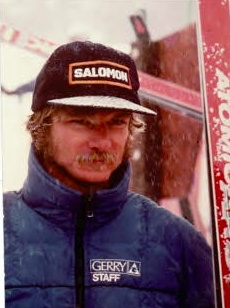Sidebar Include
To make changes, the file below must be edited. Email Carl with any questions ([email protected]).
Steve McKinney
 Hall of Fame Class of 2017
Hall of Fame Class of 2017
Bio Content
As the first skier to break the 120mph barrier, Steve McKinney dominated, defined and led the sport of speed skiing in the 1970s and ‘80s.
Steve McKinney was larger than life, a 6-foot, 4-inch Viking warrior who became known as the “High Priest of Speed Skiing” as he steered the sport out of the shadows and into the spotlight. Philosophical, adventurous, charismatic and slightly mysterious, he thoroughly dominated speed skiing in the 1970a and’80s, setting seven world records and becoming the first human being to break the 120 mph and 200kph barriers on skis.
Born in Baltimore in 1953, McKinney was the fourth child in the famous McKinney skiing clan, which included his younger half-sister, Tamara, who was inducted into the Hall of Fame in 1984. A natural athlete who excelled in every sport he tried (football, tennis, waterskiing, surfing and competitive show jumping among them), he was diagnosed with rheumatic fever at age 15 and told he’d never participate in sports again because of the painful, debilitating condition. The doctor was wrong.
McKinney grew up skiing and racing around Lake Tahoe, advancing to the U.S. Ski Team as a downhill specialist in 1971 where he was joined by two other McKinney siblings, McLane and Sheila. Independent-minded, he clashed with authorities and left the team in 1973 after losing his amateur status for appearing in an advertisement for long underwear.
Introduced to speed skiing by former record holder Dick Dorworth, the rebellious McKinney found it to be his perfect calling. He made his first tentative runs in 1973 on the Kilometro Lanciato in Cervinia, Italy while still strapped in a body cast from a broken back. When he returned the next year, he managed to borrow the race kit from a retiring Italian speed skier and set his first record at 117.473 mph.
“Off I went,” recalled McKinney of that first record-breaking run. “A few harsh moments over the top bumps…then into the fearful, yet strangely comfortable, current; I discovered the middle path of stillness within speed, calmness within fear and I held it longer and quieter than ever before.” Italian race fans immediately embraced this generous, outgoing American with the long blonde hair and beard, parading their new hero down the streets of Cervinia.
In 1977 in Portillo, Chile, McKinney became the first to surpass the 120 mph mark and the next season on the same track, he blew by the 200 kph barrier, a mark that would stand for four years. His last world record came in 1987. (The current speed skiing record is 158 mph).
“Racing for pure speed is uncomplicated, straight forward and decisive,” McKinney observed. “He marked (speed skiing) more than anyone,” Dorworth says. “He was special.”
McKinney drove innovations in the sport, introducing rubberized speed suits and, after working in a wind-tunnel with an FAA engineer, the aerodynamic Trout Head Helmet. With cardboard, duct tape and a DIY bent, he created fairings to reduce wind drag on his ski boots. McKinney helped lead the way in creating the first professional speed skiing association and later would bring it to the general public with the NASTAR-like McKinney Speed Challenge. He also recognized that the sport needed to return to the FIS-sanctioned World Cup, which led to its brief inclusion as an Olympic demonstration sport in 1992 at Albertville, France (the IOC would ultimately deem it too dangerous).
Besides his speed-skiing exploits, McKinney was an acclaimed mountain climber and guide and the first person to hand-glide off Mount Everest, soaring from the 22,000 foot West Ridge in 1986. He was an unrivaled “extreme” and “big-mountain skier well before those terms were coined and he often did it on 222-centimeter downhill skis.
Frequently plagued by serious injuries (though never from speed skiing), McKinney died on November 10, 1990 in a roadside car accident while on his way to a business meeting in San Francisco.
Tamara McKinney, who was named to the U.S. Ski Team in 1977 and would become the country’s first overall World Cup champion, recalls “Stevie” honing her downhill tuck on the kitchen island at home, pushing her into a lower, more aerodynamic position with the abdomen to “Find the calm.”
“Steve had the confidence of a king and the personality of a fun-loving sage,” she says. “He was ‘The Man’ in an endeavor that answers the question that occurs to every person who ever put on a pair of skis, even to those who do not wish to find out the answer: ‘How fast can I go?”
Career Highlights:
1971-73: Member of U.S. Ski Team
1974: World Speed Skiing Record/Cervinia, Italy (11,473 mph/189.473 kph)
1977: World Speed Skiing Record/Portillo, Chile (121.024 mph/195.200 kph)
1978: World Speed Skiing Record/Portillo, Chile (124.137 mph/200.222 kph)
1978: Formed International Speed Skiing, the first professional speed skiing circuit
1982: World Speed Skiing Record/Les Arcs, France (124.7562 mph/201.230 kph)
1986: Becomes first person to hand-glide off Mount Everest, soaring from the 22,000-foot West Ridge
1986: Proposed FIS governance of speed skiing, and inclusion as demonstration sport in 1992 Olympics
1987: World Speed Skiing Record/Les Arcs, France (130.487 mph/209.790 kph; personal best)
1992-93: Posthumously awarded with the North American Snowsports Journalists Association’s inaugural Lifetime Achievement Award for contributions to skiing
Video Include
To make changes, the file below must be edited. Email Carl with any questions ([email protected]).
Hall of Fame Tribute Video
Corrections?
If you notice any errors or inconsistencies in Steve McKinney's bio, click here to let us know.
Please fill out the form to report any errors present on this page. We will correct them as soon as we can. Thanks for taking the time to let us know of any mistakes!

